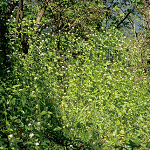Success stories: Tales of improving our native biodiversity
Mandy Tu & Barry Rice/GIST
November 2001
Update! (31 July 2002)
Unfortunately, this summer (2002) Phil Johnson (discoverer of the Alliaria discussed on this web page) found that the plant found in 2001 was only an outlier of a much larger population. The situation is beyond the scope of a small volunteer project to amend. Regional biologists are considering their options. Whether the infestation is eliminated, halted, or allowed to expand depends largely upon the speed and effectiveness of the management that will occur while the infestation is still small. Those interested in the control of this invader should contact members of the Alaskan coalition called CNIPM (Committee for Noxious and Invasives Plant Management, pronounced "snip-em").
Photographs
Click
on the images below to view photographs related
to this success story.

|

|
The Setting
Southeast Alaska is home to the cities of Juneau, Sitka, and Ketchikan,
over 1,000 islands of the Alexander Archipelago, and to the Tongass
National Forest, which at 17 million acres (7 million hectares) is the
largest national forest in the U.S. The Tongass is rich in native
biodiversity and encompasses forests, estuaries, peatlands, scrublands,
large networks of islands, valley bottoms, rugged mountain slopes and ice
fields. It also contains the largest contiguous expanse of temperate rain
forest in the world and is home to more than 300 native wildlife species,
including grizzly bears, moose, bald eagles, and wild salmon.
The Invader - Garlic mustard
(Alliaria petiolata)
Garlic mustard is a highly competitive and aggressive non-native
herbaceous plant that forms dense populations in the understory of
deciduous forests, forest edges, hedgerows, shaded roadsides, and riparian
and urban areas in the northeastern and north-central U.S and adjacent
Canada. It can occur in areas with shade or full sun, and in a variety of
soil conditions. Once established, garlic mustard can completely dominate
and displace native plants in the rich herbaceous understory layer, which
is vital habitat for many indigenous plant, animal, and insect species.
Garlic mustard is native to northern Europe, and was first collected in the U.S. in New York in 1868 (Nuzzo 2000). It is now present in 34 states in the U.S. and 4 provinces in Canada. Northeastern and the midwestern states report the worst infestations (USDA-NRCS 2001) but garlic mustard is also present in Oregon, Washington State, and in British Columbia. Until now, however, there was no documented report of garlic mustard in Alaska (A. Denton, pers. comm.; E. Haber, pers. comm.; S. Reichard, pers. comm.).
A Success Story
Phil Johnson is a microcomputer specialist and naturalist in Juneau,
Alaska. One day in the spring of 2001, as he walked from his car to his
office building, he noticed a plant he had never seen before growing in
the landscaping borders of his parking lot. Phil knew the natural history
of Alaska well enough to recognize that this plant was not native. It
sparked his curiosity immediately. He called a local botanist-author--Carol
Biggs (http://www.alaska.net/~aknature/)--who
recognized the plant as garlic mustard. Phil then did some web searching
and found The Nature Conservancy's Weeds-on-the-Web web site, which
documented this plant's invasive qualities. Phil contacted The Nature
Conservancy's Associate Scientist, Dr. Barry Rice. At Barry's
encouragement, Phil carefully removed the entire plant from the site and
sent in the pressed and dried specimen to the University of California Davis
Herbarium, where Dr. Ellen Dean, the herbarium curator, positively
identified it as garlic mustard (Alliaria petiolata). A second
expert, Dr. Robert Preston, was asked to independently identify the plant.
His diagnosis was the same: garlic mustard!
Due to Phil Johnson's early detection of the newly established garlic mustard, followed by his quick actions to eliminate it, this aggressive invader may no longer be an immediate threat to the biodiversity of southeast Alaska. Phil is now vigilantly monitoring this site periodically for any surviving garlic mustard plants. Once garlic mustard becomes established and begins to spread it is very difficult to control. It spreads rapidly by seed and displaces native herbaceous species in the forest understory. The recovery of heavily infested communities following garlic mustard removal, requires intensive replanting and restoration efforts (Nuzzo 2000).
Phil is not resting as a result of his success with garlic mustard---other invasive plants are still making headway into Alaska. Phil is going to take on Japanese knotweed (Polygonum cuspidatum) next. This non-native plant aggressively invades and can dominate coastal and riparian habitats in the Pacific Northwest from northern California to southern Alaska. He is also worried about a non-native forget-me-not, because it has become established in the wild and may be displacing Alaska's state flower, the native forget-me-not, Myosotis alpestris.
More Information
For more information, contact Barry Rice, Associate Scientist of
TNC's Wildland Invasive Species Team at 530-754-8891 or at
bamrice(at)ucdavis.edu. A review by Vicki Nuzzo with more detailed
information about garlic mustard, including a description of its
diagnostic characteristics, range, ecology, and methods for its control,
is available on the TNC's Wildland Invasive Species Team
Weeds-on-the-Web site
(http://tncinvasives.ucdavis.edu/esadocs/documnts/allipet.html).
References
Denton, A. 2001. Curator, Herbarium of the University of Alaska,
Fairbanks. Personal communication.
Haber, E. 2001. National Botanical Services, Invasive Plants of
Canada. Personal communication.
Morisawa, T. 2000. Weed Alert: Alliaria petiolata. The Nature
Conservancy's Wildland Invasive Species Team
(http://tncinvasives.ucdavis.edu/alert/alrtalli.html), accessed 11/2001.
Nuzzo, V. 2000. Element Stewardship Abstract: Alliaria petiolata.
The Nature Conservancy's Wildland Invasive Species Team
(http://tncinvasives.ucdavis.edu/esadocs/documnts/allipet.html),
accessed 11/2001.
Reichard, S. 2001. Professor, University of Washington. Personal
communication.
USDA, NRCS. 2001. The PLANTS Database, Version 3.1
(http://plants.usda.gov). National Plant Data Center, Baton Rouge,
LA 70874-4490 USA, accessed 11/2001.
This document in other formats: MS Word, Adobe Acrobat
This article may be treated as a press release and may be quoted by the media in part or in full. Publication quality versions of images on this page can be obtained from the Wildland Invasive Species Team by sending email to bamrice(at)ucdavis.edu.


